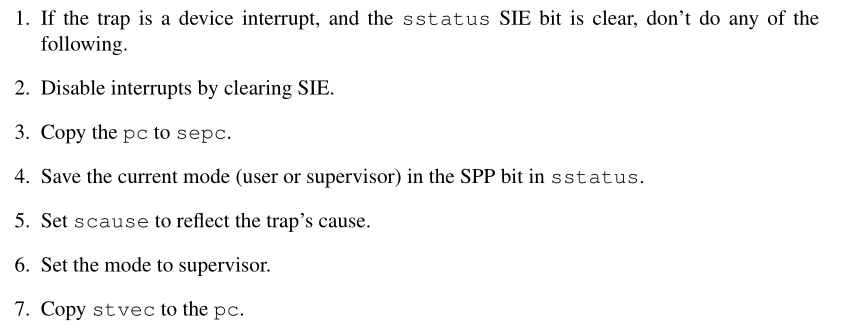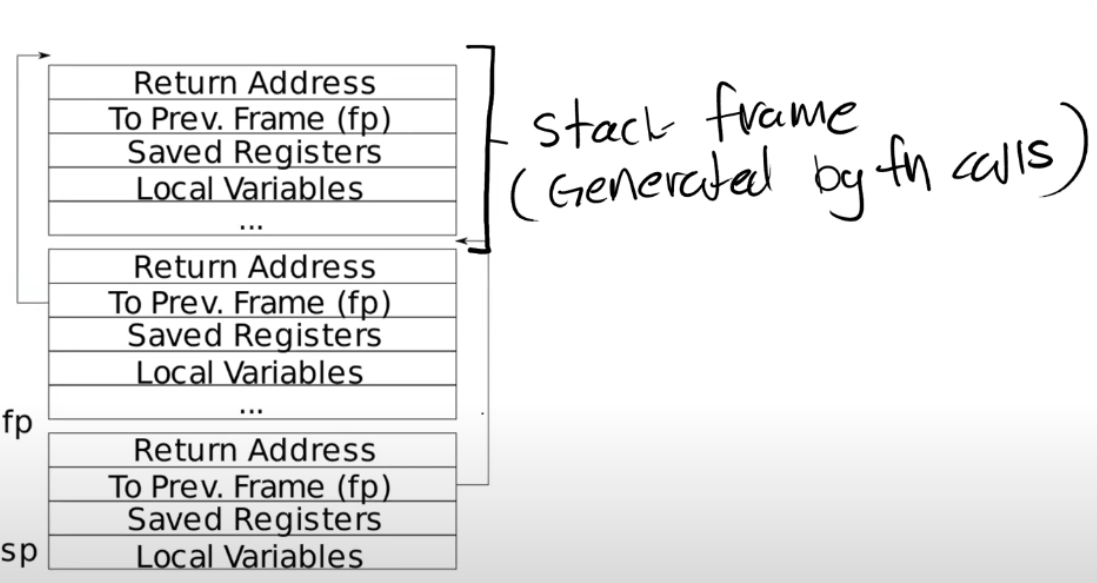Lab 4 - Trap
课程
基本概念
- 用户态中,RISC-V有32个用户寄存器以及SATP寄存器(User page table),trap需要将这些寄存器保存,并切换SATP到kernel page table。
- 内核态的切换中将会使用以下寄存器
- stvec:trap handler的位置
- sepc:保存用户的pc寄存器,sret等需要用到。
- scause:reason for the trap
- sstatus:其中,SIE bit表示device interrupts的enable;而SPP表示目前处于那个模式。
- 基本的trap过程:
 + start executing at the new pc.
+ start executing at the new pc. - supervisor mode:实际上,supervisor mode可做的事很少。其相比于User mode,可以读写控制寄存器(也就是satp,stvec这些),以及使用PTE_U标志位为0的PTE,除此之外便无法进行,读取地址也只能依靠kernel page table。
uservec以及之前
该trap为用户态系统调用等。 例如,用户态中通过shell调用write的时候会有:

其便会在a7寄存器寄存值,调用系统调用;且在其他寄存器配置write的基本参数,ecall进入uservec(trampoline)中。此时,ecall做了三件事:
- user mode-> supervisor mode
- pc-> sepc
- jump to stvec(此处为trampoline的起始地址,也就是uservec).
此时,需要uservec做以下事:
- 保存32个用户寄存器
- 切换kernel page table
- 创建或找到kernel stack,改变sp。
- jump to kernel C code(usertrap)
以上步骤均通过uservec的汇编代码执行。需要注意的是,trampoline和trapframe(用户寄存器以及kernel寄存器保存处)在user 和kernel page table中都是固定的,这防止了因ecall导致的可能的页表错误。
汇编代码中的sscratch用于移除a0,让接下来的保存寄存器等操作可以通过a0实现。
usertrap
该函数如下所示:
void
usertrap(void)
{
int which_dev = 0;
if((r_sstatus() & SSTATUS_SPP) != 0)
panic("usertrap: not from user mode");
// send interrupts and exceptions to kerneltrap(),
// since we're now in the kernel.
w_stvec((uint64)kernelvec);
struct proc *p = myproc();
// save user program counter.
p->trapframe->epc = r_sepc();
if(r_scause() == 8){
// system call
if(p->killed)
exit(-1);
// sepc points to the ecall instruction,
// but we want to return to the next instruction.
p->trapframe->epc += 4;
// an interrupt will change sstatus &c registers,
// so don't enable until done with those registers.
intr_on();
syscall();
} else if((which_dev = devintr()) != 0){
// ok
} else {
printf("usertrap(): unexpected scause %p pid=%d\n", r_scause(), p->pid);
printf(" sepc=%p stval=%p\n", r_sepc(), r_stval());
p->killed = 1;
}
if(p->killed)
exit(-1);
// give up the CPU if this is a timer interrupt.
if(which_dev == 2)
yield();
usertrapret();
}
感觉还是很好理解的。其做了以下事情:
- 检查SPP等。
- 在内核进行任何操作之前,写入kernelvec,使得若发生kernel trap(一般而言就是exception)跳转到kernelvec。
- 保存用户程序计数器(防止切换改变SEPC)
- 根据不同情况,进行不同的处理。
usertrapret
void
usertrapret(void)
{
struct proc *p = myproc();
// we're about to switch the destination of traps from
// kerneltrap() to usertrap(), so turn off interrupts until
// we're back in user space, where usertrap() is correct.
intr_off();
// send syscalls, interrupts, and exceptions to trampoline.S
w_stvec(TRAMPOLINE + (uservec - trampoline));
// set up trapframe values that uservec will need when
// the process next re-enters the kernel.
p->trapframe->kernel_satp = r_satp(); // kernel page table
p->trapframe->kernel_sp = p->kstack + PGSIZE; // process's kernel stack
p->trapframe->kernel_trap = (uint64)usertrap;
p->trapframe->kernel_hartid = r_tp(); // hartid for cpuid()
// set up the registers that trampoline.S's sret will use
// to get to user space.
// set S Previous Privilege mode to User.
unsigned long x = r_sstatus();
x &= ~SSTATUS_SPP; // clear SPP to 0 for user mode
x |= SSTATUS_SPIE; // enable interrupts in user mode
w_sstatus(x);
// set S Exception Program Counter to the saved user pc.
w_sepc(p->trapframe->epc);
// tell trampoline.S the user page table to switch to.
uint64 satp = MAKE_SATP(p->pagetable);
// jump to trampoline.S at the top of memory, which
// switches to the user page table, restores user registers,
// and switches to user mode with sret.
uint64 fn = TRAMPOLINE + (userret - trampoline);
((void (*)(uint64,uint64))fn)(TRAPFRAME, satp);
}
trampoline中的SEPC实际上可以不用在usertrap里保存,这里的保存顺序是没有必然联系的。
userret
汇编代码,其做了以下事:
- 切换 page table。
- restore user register。
- a0改为return的返回值(sscratch)
- sret
sret执行以下部分:
- 切换回user mode
- SPEC保存至PC寄存器
- 重新打开中断
以上过程中,xv6尽可能地使系统调用看上去像是函数,但实际上是需要一个层级的调用过程。
kernel trap
该部分。。其实和user trap差不多,但简单一点。
kernelvec只在栈里保存和恢复寄存器,而kerneltrap处理interrupts(time)和exception。
RISC-V assembly (easy)
这部分是简单的对着代码进行分析,让学生熟悉RISC-V的。但xv6的RISC-V并不用完整写一个程序,所以我这种完全不会RISC-V的也可以上手。
摆一张图:

用别人图床不也挺好吗
分析的代码部分:
user/_call: file format elf64-littleriscv
Disassembly of section .text:
0000000000000000 <g>:
#include "kernel/param.h"
#include "kernel/types.h"
#include "kernel/stat.h"
#include "user/user.h"
int g(int x) {
0: 1141 addi sp,sp,-16
2: e422 sd s0,8(sp)
4: 0800 addi s0,sp,16
return x+3;
}
6: 250d addiw a0,a0,3
8: 6422 ld s0,8(sp)
a: 0141 addi sp,sp,16
c: 8082 ret
000000000000000e <f>:
int f(int x) {
e: 1141 addi sp,sp,-16
10: e422 sd s0,8(sp)
12: 0800 addi s0,sp,16
return g(x);
}
14: 250d addiw a0,a0,3
16: 6422 ld s0,8(sp)
18: 0141 addi sp,sp,16
1a: 8082 ret
000000000000001c <main>:
void main(void) {
1c: 1141 addi sp,sp,-16
1e: e406 sd ra,8(sp)
20: e022 sd s0,0(sp)
22: 0800 addi s0,sp,16
printf("%d %d\n", f(8)+1, 13);
24: 4635 li a2,13
26: 45b1 li a1,12
28: 00000517 auipc a0,0x0
2c: 7c050513 addi a0,a0,1984 # 7e8 <malloc+0xea>
30: 00000097 auipc ra,0x0
34: 610080e7 jalr 1552(ra) # 640 <printf>
exit(0);
38: 4501 li a0,0
3a: 00000097 auipc ra,0x0
3e: 27e080e7 jalr 638(ra) # 2b8 <exit>
这里是解答部分:
Which registers contain arguments to functions? For example, which register holds 13 in main's call to printf?
a0------a7. 13 存储在a2.
Where is the call to function f in the assembly code for main? Where is the call to g? (Hint: the compiler may inline functions.)
编译器优化直接内联展开了。
At what address is the function printf located?
0000000000000630 <printf>。
What value is in the register ra just after the jalr to printf in main?
返回的地址ra是main里头的对应行数的地址。
Run the following code. What is the output? The output depends on that fact that the RISC-V is little-endian. If the RISC-V were instead big-endian what would you set i to in order to yield the same output? Would you need to change 57616 to a different value?
unsigned int i = 0x00646c72;
printf("H%x Wo%s", 57616, &i);
大端小端的问题...计组都搞过了,不回答😤😤😤
In the following code, what is going to be printed after 'y='? (note: the answer is not a specific value.) Why does this happen?
printf("x=%d y=%d", 3);
未定义行为,当前的a2寄存器不知道是什么值,因此输出也是未知的。
Backtrace (moderate)
实现一个回溯的Backtrace。
还是很简单的一道题,用指针就行了,我还在想用什么指令来访问物理内存。自己做这些题还是容易舍近求远。
本题目需要理解下图:

在每一层的堆栈中,return address位于frame pointer的offset(-8)位置,而上一个frame pointer在当前frame pointer offset(-16)位置,因此若要存取上一个堆栈信息,可以直接用指针的加减来获得。
首先在kernel/defs.h等地方加上必要的配置,例如函数声明等。
然后增加以下函数声明:
static inline uint64
r_fp()
{
uint64 x;
asm volatile("mv %0, s0" : "=r" (x) );
return x;
}
该函数可以获取当前帧指针s0的值。
void backtrace(){
printf("backtrace:\n");
uint64 fp = r_fp();
uint64 start = PGROUNDUP(fp), end = PGROUNDDOWN(fp);
while(end<=fp&&fp<=start){
printf("%p\n", *(uint64*)(fp-8));
fp = *(uint64*)(fp-16);
}
}
其中的start和end变量是为了防止fp的无限回溯超出界限。xv6会将每一个stack都分配一个page,因此用PGROUNDUP等宏即可获取上下限。
Alarm (hard)
按照他的步骤来就算简单。
本题要求增加两个系统调用:sigalarm和sigreturn。
除了增加系统调用所必要的修改外,其他修改如下:
由于跳转函数会破坏寄存器的值,因此需要在proc结构里保存寄存器的值。这里的实现是有些偷懒的,只根据alarmtest.asm里的所需值增加了所需要的寄存器:sp,pc,s0-s1, ra以及a0-a7,但实际上无从知道编译器会用哪些用户寄存器,因此在实际使用的时候应该将32个寄存器全部存储。
struct proc {
//...
uint64 ticks; //时间间隔
uint64 func; //执行的函数指针
uint64 count; //经过多长时间
uint64 alarm_epc; //保存的pc寄存器
uint64 in_handler; //是否有return
// 保存的寄存器
uint64 sp;
uint64 s0;
uint64 s1;
uint64 ra;
uint64 a0;
uint64 a1;
uint64 a2;
uint64 a3;
uint64 a4;
uint64 a5;
uint64 a6;
uint64 a7;
};
allocproc函数里也增加初始化内容:
static struct proc*
allocproc(void)
{
found:
//.....
p->count = 0;
p->ticks = 0;
p->func = 0;
p->alarm_epc = 0;
p->in_handler = 0;
p->a0 = p->a1 = p->a2 = p->a3 = p->a4 = p->a5 = p->a6 = p->a7 =0;
p->sp = p->ra = p->s0 = p->s1 = 0;
return p;
}
两系统调用:
uint64
sys_sigalarm(void){
int ticks;
uint64 func;
if(argint(0, &ticks) < 0 && argaddr(1, &func)<0){
return -1;
}
struct proc *p = myproc();
func = p->trapframe->a1;
printf("%p\n", func);
if(ticks == 0 && func == 0){
p->ticks = p->func = p->count = 0;
return 0;
}
p->ticks = ticks;
p->func = func;
p->count = 0;
return 0;
}
uint64
sys_sigreturn(void){
struct proc *p = myproc();
if (p->in_handler){
p->trapframe->epc = p->alarm_epc;
p->count = 0;
p->in_handler = 0;
p->trapframe->a0 = p->a0;
p->trapframe->a1 = p->a1;
p->trapframe->a2 = p->a2;
p->trapframe->a3 = p->a3;
p->trapframe->a4 = p->a4;
p->trapframe->a5 = p->a5;
p->trapframe->a6 = p->a6;
p->trapframe->a7 = p->a7;
p->trapframe->sp = p->sp;
p->trapframe->s0 = p->s0;
p->trapframe->s1 = p->s1;
p->trapframe->ra = p->ra;
}
return 0;
}
void
usertrap(void)
{
// ...
// give up the CPU if this is a timer interrupt.
if(which_dev == 2){
if (p->func||p->ticks){
p->count++;
if (p->count==p->ticks){
p->in_handler = 1;
p->alarm_epc = p->trapframe->epc;
p->trapframe->epc = p->func;
p->a0 = p->trapframe->a0;
p->a1 = p->trapframe->a1;
p->a2 = p->trapframe->a2;
p->a3 = p->trapframe->a3;
p->a4 = p->trapframe->a4;
p->a5 = p->trapframe->a5;
p->a6 = p->trapframe->a6;
p->a7 = p->trapframe->a7;
p->sp = p->trapframe->sp;
p->s0 = p->trapframe->s0;
p->s1 = p->trapframe->s1;
p->ra = p->trapframe->ra;
}
}
yield();
}
usertrapret();
}